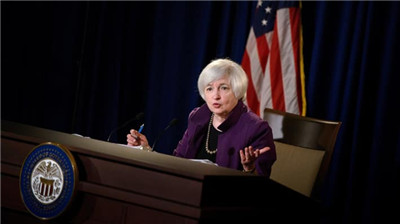(单词翻译:单击)
It is curious to reflect that when US and UK policy interest rates were cut to their lowest ever levels in March 2009, markets expected them to be on the rise within the year. More than six years later the rates remain the same and the markets are still obsessed with the timing of a rise. When that will happen is as clear as mud in the wake of after the Federal Open Market Committee’s statement last week.
2009年3月英美政策利率被降至其历史最低水平后,市场预期两者在当年内就会上升,现在想到这一点让人费解。6年多过去了,利率一直保持在相同的极低水平,而市场仍纠结于加息时机。在联邦公开市场委员会(FOMC)上周发表声明之后,何时加息仍是个未知数。

The one thing that is bIt is beyond doubt that the “normalisation” of monetary policy is a long way off. Janet Yellen, chairwoman of the Federal Reserve, has indicated that when the rises do come they will be small, incremental and predictable. For some years we will be in a subnormal interest rate world.
只有一点毋庸置疑,那就是货币政策“正常化”离我们还很远。美联储(Fed)主席珍妮特•耶伦(Janet Yellen,见上图)表示,当真的开始加息时,加息将是小幅、渐进和可预测的。未来好几年,我们将生活在一个利息低于正常水平的世界里。
It will also be a low growth world — witness the downward revisions to growth projections of both the Federal Reserve and the Bank of England this month. The eurozone and Japan, despite enjoying the benefits of big competitive devaluations, are struggling to deliver half-decent growth rates.
这也将是一个低增长的世界——看看吧,本月美联储和英国央行(BoE)都调低了本国的预期增长率。欧元区和日本尽管享受着大幅竞争性贬值的好处,但仍难以达到像样的增长率。
And competitive devaluation is anyway a zero sum game that does nothing to boost the global economy. China is slowing palpably even if the official figures are disguising the underlying reality. The post-crisis assumption that emerging market economies would show the developed world a clean pair of heels now no longer holds.
无论如何,竞争性贬值是一种零和游戏,对提振全球经济毫无贡献。中国明显开始放缓,尽管官方数据掩盖了根本现实。危机后有关新兴市场经济体将把发达经济体远远抛在后面的假设,如今再也站不住脚。
Against a background of inadequate global demand the collapse in energy and commodity prices has added powerful disinflationary impetus. Wage increases in the developed world, with the notable exception of the UK just recently, have been subdued.
在全球需求不足的背景下,能源与大宗商品价格崩盘增添了强大的通胀减缓动力。发达经济体的工资增长一直低迷(英国最近出现的情况是个突出的例外)。
Forward markets are telling us that interest rates are going to be muchfar lower than pre-crisis average policy rates since 1945 for the US, UK, the eurozone and Japan, which were respectively 3 per cent, 7 per cent, 3 per cent and 4 per cent.
期货市场行情告诉我们,未来美国、英国、欧元区和日本的利率将远低于从1945年至危机爆发那段时期的平均水平,后者分别为3%、7%、3%和4%。
In other words, the markets are saying that this time is different, a formulation that is reliably dangerous when it comes to predicting the future. Of course, some things really are different. For much of the postwar period most central banks were not independent, though whether independence has been the driving force behind prolonged disinflation is another matter, as is the question of whether central banks will remain independent in future.
换言之,市场在说“这次不一样”;就预测未来而言,这种说法难免是危险的。当然,有些事情真的不一样了。战后很长时期里,多数央行不是独立的——尽管央行独立地位是不是持续通胀减缓的推动因素是另一个问题,而央行未来能不能保持独立也是一个问题。
Given the quasi-fiscal nature of their activities since the crisis and the risk that unconventional measures pose to their balance sheets, the possibility of a political land-grab in monetary policy is not negligible.
鉴于危机爆发以来各央行的行动带有“准财政”性质,鉴于非常规政策对央行资产负债表构成的风险,政治插手货币政策的可能性是不可忽视的。
On the other hand, liberalisation of labour markets and the decline of union power seems unlikely to be reversed in the short and medium term. Note, though, that with ageing populations, a shrinking workforce may exercise market power to grab higher wages against a retired population that tries to use voting power to secure stable retirement incomes.
另一方面,劳动力市场自由化和工会实力衰退的趋势看来在短期和中期内不太可能逆转。不过请注意,在人口老龄化的大背景下,日益减少的劳动力或许会借助市场实力争取更高工资,而退休人群努力利用自己的选票来保住稳定的退休收入。
The dangers inherent in a subnormal interest rate world relate, first, to the accumulation of debt. Debt of almost any size in relation to gross domestic product becomes manageable at today’s negligible interest rates. Whether it stays manageable depends on whether politicians seize the opportunity to deliver structural reforms and infrastructure investment to enhance growth, without which debts cannot ultimately be serviced.
在利率低于正常水平的世界,其内在危险首先与债务积累有关。以如今可忽略的利率水平,债务相对于国内生产总值(GDP)的规模无论有多大,都是可管理的。至于债务未来能不能保持可管理,则取决于政界人士能否抓住机遇,推行结构性改革,并投资于基础设施,以推动经济增长。若非如此,债务最终将无法偿还。
The snag is that low growth makes it hard to summon up the political will for reform, which tends to impede growth in the short run before producing a longer-term pay-off.
麻烦在于,低增长使人很难调动起改革的政治意志——改革倾向于在短期内压抑增长,之后才能带来长期回报。
Then there is the problem of dismal investment returns and the impact of low discount rates on pension fund liabilities. It is impossible to know how far pension fund deficits dampenen animal spirits in the boardroom, but where pension funds are big in relation to the company, deficits cannot help.
还有就是投资回报糟糕以及低折现率加重养老基金支付负担的问题。我们不可能知道,养老基金的亏空将在多大程度上抑制董事会的“动物精神”,但在养老金规模相对于公司较大的情况下,亏空肯定不是好事。
They may well have been a factor, albeit a minor one, in the weakness of investment since 2008. Equally important, a subnormal interest rate environment reduces the scale of creative destruction and confers advantage on big companies at the expense of more productive smaller companies that lack good access to credit markets.
对于2008年以来投资疲弱的情况,养老基金亏空很可能是一个因素,尽管是个次要因素。同等重要的是,利率偏低的环境影响了“创造性破坏”的规模,把优势留给了大公司,却损害了生产率较高、但难以利用信贷市场的中小企业。
In such a world any reversion to the historic interest rate mean is distant. There is no generalised sword of Damocles hanging over the heavily indebted developed world for the momentnow. Yet for individual countries an early reversion may be the reward for bad policy. Japan and southern Europe are the laboratories in which this hypothesis will be tested.
在这样一个世界里,利率回归历史均值是非常遥远的事。目前而言,负债累累的发达经济体头上并未普遍悬挂着一柄达摩克利斯之剑。不过,对个别国家来说,较早回归是对糟糕政策的奖励。日本和南欧国家将是验证这一命题的实验室。
The writer is an FT columnist
本文作者为英国《金融时报》专栏作家


